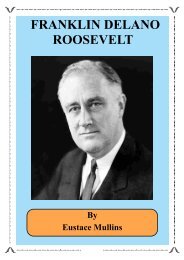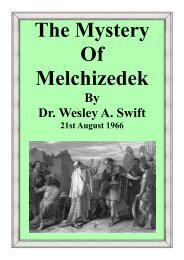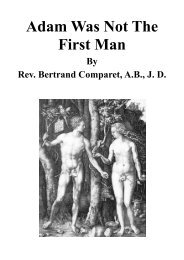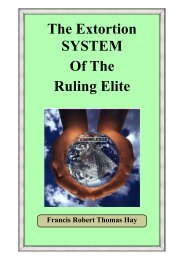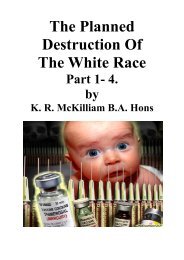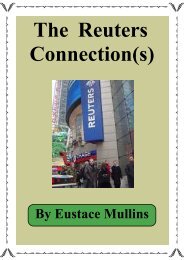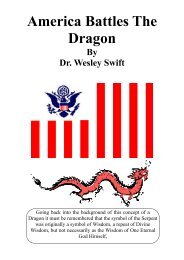Curse of Cannan - The New Ensign
Curse of Cannan - The New Ensign
Curse of Cannan - The New Ensign
Create successful ePaper yourself
Turn your PDF publications into a flip-book with our unique Google optimized e-Paper software.
As in the case <strong>of</strong> Plato, this school <strong>of</strong> philosophy was seen 10 have powers <strong>of</strong> attraction to the<br />
ruling order, and it was soon placed in service. <strong>The</strong> most powerful banker <strong>of</strong> the Renaissance,<br />
Cosimo de Medici, leader <strong>of</strong> the "black nobility" in Italy, the Guelphs, gave the money to found<br />
the Accademia Platonic a in Florence during the fifteenth century. With this financial and political<br />
support, Neoplatonism won rapid acceptance. In 1486, Pico della Mirandola presented 900 theses<br />
on this new philosophy at the Accademia; 72 <strong>of</strong> these theses were obvious Kabbalist concepts.<br />
A noted Hebrew scholar, della Mirandola based much <strong>of</strong> the philosophy <strong>of</strong> Neoplatonism on his<br />
studies in this field. By his emphasis on a universe, which is centered on man, he is credited with<br />
having anticipated the twentieth century philosophy <strong>of</strong> existentialism. Della Mirandola was<br />
succeeded at the Accademia by Johann Reuchlin, who became famous for his development <strong>of</strong><br />
"Christian cabbalism," that is, a Christian version <strong>of</strong> the Kabbalah. He also became a principal<br />
figure in the spread <strong>of</strong> the Neoplatonic doctrine. Later known more simply as "Renaissance<br />
humanism," Neoplatonism, or Christian Kabbalah, <strong>of</strong>ten excluded belief in God from its<br />
philosophy. Its principal thesis was the cabbalistic theory that matter (or life) is essentially<br />
imperfect, and thus causes disorder in an otherwise perfect world. Plato's Republic also sought<br />
to "correct" the imperfections <strong>of</strong> society by setting up a "perfect" nation, whose perfection would<br />
have to be protected and sustained by a dictatorship; this became the foundation <strong>of</strong> all future<br />
schemes for "utopia," the most well known <strong>of</strong> these being Communism. Marx proclaimed that<br />
when this state <strong>of</strong> perfection had been reached, the state would wither away and would no longer<br />
be required to exercise dictatorial powers. However, no Communist state has yet reached this<br />
state <strong>of</strong> perfection. This was the goal <strong>of</strong> perfection which originated in a revulsion against the<br />
life process; because <strong>of</strong> this revulsion, "humanists" had no qualms about murdering sixty-six<br />
million humans in Soviet Russia. This was the result <strong>of</strong> Neoplatonism's "perfect marriage"<br />
between the Kabbalah and the Oriental precepts <strong>of</strong> Gnosticism, a union based on the denial <strong>of</strong><br />
God's role in the Universe.<br />
<strong>The</strong> combination <strong>of</strong> high finance, in the person <strong>of</strong> the Medici, and Neoplatonism, which <strong>of</strong>fered<br />
the possibility <strong>of</strong> unlimited behavior control, created a situation which was made to order for the<br />
Canaanites in their continuing battle against the people <strong>of</strong> Shem. Plotinus and his pupil, Porphyry,<br />
had developed the basic aspect <strong>of</strong> Neoplatonism, that the First Principle and source <strong>of</strong> reality,<br />
the One, or Good, transcends being and thought, and is naturally unknowable. Gnosticism always<br />
begins with the precept that certain things are "unknowable," but that their hidden meanings can<br />
be revealed to a select group who have gone through the proper rites <strong>of</strong> initiation. Thus the<br />
doctrine <strong>of</strong> Neoplatonism became the ideal vehicle for the new worldwide secular priesthood,<br />
the heirs <strong>of</strong> the rites <strong>of</strong> Baal, but clothed now in the cultural garments <strong>of</strong> the Renaissance, and<br />
later, the Enlightenment. Its final phase was the Illuminati, the secret sect which directs<br />
Freemasonry.<br />
<strong>The</strong> Oxford English Dictionary defines humanism as concern with merely human interests, as<br />
distinct from divine. In the Notes, we find, "1716; M. Devion Athen. Brit. 170, '<strong>The</strong>ir Jesuit<br />
boasting Monopoly and bragging tyranny over Humanistical Schools.' "<br />
Because humanism was based on the relativism <strong>of</strong> Protagorus, it developed successively into<br />
the Renaissance, the Reformation, the Enlightenment, Marxism, and Freudianism ... Freudianism<br />
then developing its own <strong>of</strong>fshoots <strong>of</strong> feminism, bisexuality, and the drug culture. Humanism<br />
became the guiding force <strong>of</strong> the development <strong>of</strong> Socialism and Fabianism in England and the<br />
United States. Its principal propagandists were careful to establish that humanism was based on<br />
atheism, amorality, and a Socialist One World State. Corliss Lamont, the son <strong>of</strong> a partner in the<br />
firm <strong>of</strong> J. P. Morgan Co. became the principal spokesman for humanism 11 the United States.<br />
He says, " A truly Humanist civilization must be a world civilization." He drafted a Humanist<br />
Wedding Ceremony which is now widely used to replace the traditional Christian rite.<br />
In 1953, an <strong>of</strong>ficial Humanist Manifesto appeared. It states (I) the universe is self-existing and<br />
not created; (2) man is pmt <strong>of</strong> nature (the noble savage, as defined by Rousseau, the precursor<br />
( Page 38)



